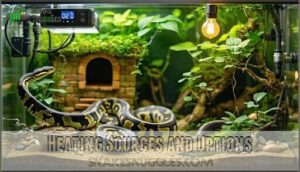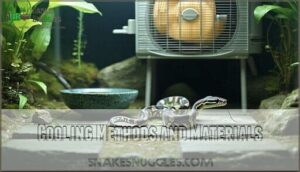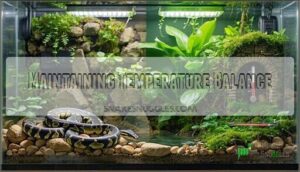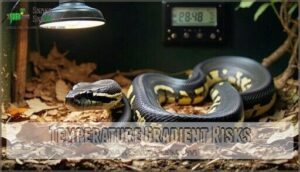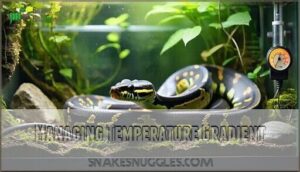This site is supported by our readers. We may earn a commission, at no cost to you, if you purchase through links.

This gradient mimics their natural habitat where they’d move between sun-warmed rocks and cool burrows.
Your snake needs this temperature difference to thermoregulate by choosing warmer spots for digestion and cooler areas for rest.
Without proper gradients, ball pythons can’t control their body temperature, leading to poor appetite, sluggish behavior, and health issues.
The gradient acts like a natural thermostat, letting your snake self-regulate its temperature needs throughout the day.
Getting this setup right involves strategic heating placement and careful monitoring to ensure the well-being of your ball python, providing them with the necessary conditions to thrive in their enclosure with a suitable temperature range for digestion.
Table Of Contents
- Key Takeaways
- Ball Python Temperature Needs
- Creating Temperature Gradient
- Temperature Gradient Benefits
- Temperature Gradient Risks
- Managing Temperature Gradient
- Frequently Asked Questions (FAQs)
- Do ball pythons need a temperature gradient?
- What does the temperature gradient tell us?
- What happens if the temperature gradient is higher?
- What does a large temperature gradient mean?
- What thermostats work best for ball pythons?
- How often should temperatures be checked daily?
- Can ceramic heat emitters be used overnight?
- What happens during seasonal temperature changes?
- How do substrate types affect temperature retention?
- Conclusion
Key Takeaways
- You’ll need a temperature gradient of 88-92°F on the warm side and 75-80°F on the cool side – this thermal range mimics your ball python’s natural habitat and allows proper thermoregulation for digestion and rest.
- Your snake can’t survive without this gradient – ball pythons rely on moving between warm and cool zones to control their body temperature, and without it they’ll develop poor appetite, sluggish behavior, and serious health issues.
- You’ll need the right heating equipment and monitoring tools – use heat mats, ceramic emitters, or radiant panels with reliable thermostats and digital probes to maintain consistent temperatures safely.
- You must check temperatures twice daily – regular monitoring prevents dangerous fluctuations that can cause heat stress, burns, respiratory infections, or immune system problems in your ball python.
Ball Python Temperature Needs
Your ball python needs a proper temperature gradient to stay healthy and comfortable.
Setting up the right warm and cool zones in their enclosure mimics their natural environment and helps them regulate their body temperature effectively.
Ideal Temperature Range
Your ball python needs precise temperatures to thrive. The ideal temperature range creates a thermal highway your snake uses daily.
Set your warm side to 88-92°F and cool side to 75-80°F for peak health.
Essential temperature monitoring tools:
- Accurate Thermometers – Digital probes prevent dangerous guesswork
- Optimal Thermostat – Controls heating elements for safe basking zones
- Night Temperatures – Maintain 75-78°F when lights dim
Humidity impact affects temperature regulation, so monitor both parameters simultaneously.
Temperature Gradient Importance
Creating proper python temperature gradient isn’t optional—it’s essential for your snake’s survival.
Temperature regulation drives metabolism boost, behavior encouragement, stress reduction, and disease prevention.
Without gradient benefits, your ball python can’t thermoregulate effectively.
This reptile heating system mimics natural conditions where snakes move between warm and cool areas throughout the day.
A proper temperature gradient aids digestion and overall health.
Warm and Cool Side Requirements
Your ball python needs distinct temperature zones to thrive.
Set your basking spot at 88-92°F with a warm hide nearby. The cool side should stay between 75-80°F with its own cool hide.
Use temperature probes and thermostat control to monitor each zone. This python temperature gradient lets your snake regulate its body temperature naturally, moving between zones as needed for proper digestion and comfort.
Creating Temperature Gradient
Creating a proper temperature gradient requires the right heating equipment and careful positioning within your snake’s enclosure.
You’ll need to balance heat sources on one side while allowing natural cooling on the other to establish the essential warm-to-cool temperature range your ball python needs for ideal health.
Heating Sources and Options
You’ll need the right heat source to create that perfect temperature gradient your ball python craves.
Here are five effective heating options:
- Heat Mats – Under-tank heaters providing steady belly heat for proper digestion
- Ceramic Heat Emitters – Overhead radiant heat without visible light, perfect for nighttime
- Radiant Panels – Even heating for large enclosures with reduced burn risk
- Heat Lamps – Focused warmth but may dry enclosure air
- Basking Bulbs – Targeted heating for specific areas
Always pair your chosen heat source with a reptile thermostat for safety and temperature control.
Many reptile owners find under tank heaters particularly useful.
Cooling Methods and Materials
While heating keeps your ball python temperature gradient warm, cooling the other end requires different techniques.
Water bowls on the cool side create evaporation that naturally lowers temperature. Ceramic tiles and slate surfaces stay cooler than substrates like coconut fiber.
Small USB fans boost ventilation needs without disturbing your snake. Elevated hides let your python access cooler upper air away from warm substrate below.
Maintaining proper ventilation is key, as poor airflow causes overheating, and this is crucial for preventing overheating and ensuring your snake’s health in its temperature gradient with cooler upper air.
Maintaining Temperature Balance
Consistent monitoring keeps your ball python temperature gradient stable throughout day and night cycles.
Regular checks prevent thermoregulation issues that disrupt basking behavior and nocturnal drops.
- Check thermometers twice daily to catch temperature swings early
- Adjust heating elements seasonally as ambient room temperatures change
- Monitor thermal inertia of substrate materials affecting heat retention, ensuring a stable temperature gradient for optimal basking behavior and preventing nocturnal drops.
Temperature Gradient Benefits
A proper temperature gradient helps your ball python regulate its body temperature and supports essential biological functions.
This thermal variation allows your snake to choose the right spot for digestion, activity, and rest throughout the day, which is crucial for its overall health and temperature regulation.
Promoting Healthy Metabolism
Your ball python’s temperature gradient directly impacts enzyme activity and digestion efficiency.
When temperatures stay within the proper range, digestive enzymes work efficiently, breaking down food completely.
This improves nutrient absorption and maintains a healthy metabolic rate.
Proper thermal regulation through your temperature gradient setup supports essential ball python care, ensuring your snake processes meals effectively and stays hydrated.
A proper heat source is essential for this process.
Encouraging Natural Behavior
Your ball python’s temperature gradient mimics wild conditions where snakes move between warm and cool areas throughout the day.
This natural thermoregulation drives essential behaviors like proper digestion after feeding and selecting ideal hiding spots.
The basking spot encourages active hunting patterns, while cooler zones promote rest cycles, creating a dynamic snake enclosure that supports ideal ball python care through natural behavioral expression.
Reducing Stress and Disease
Temperature control directly impacts your ball python’s immune system and overall well-being.
Proper temperature gradients reduce stress by allowing natural thermoregulation, which strengthens disease resistance. Consistent temperatures prevent respiratory infections and support healthy digestion.
When reptile husbandry includes ideal temperature control, you’ll notice fewer health issues requiring veterinary care, creating a foundation for long-term reptile health success by ensuring proper temperature gradients.
Temperature Gradient Risks
Wrong temperature ranges can seriously harm your ball python’s health. You’ll face risks from both overheating and underheating that can lead to burns, respiratory infections, or even death.
High Temperature Dangers
Excessive heat poses serious risks to your ball python’s health.
Heat stress can quickly become fatal for your ball python without proper temperature control.
When temperatures exceed ideal ranges, your snake can quickly develop life-threatening conditions.
Key dangers include:
- Overheating Symptoms – gaping mouth, restlessness, and escape attempts
- Dehydration Risks – rapid moisture loss leading to organ failure
- Burn Prevention – direct contact with faulty heating elements causes severe injury
Thermostat Malfunctions can create temperature extremes that trigger heatstroke threats within hours.
Low Temperature Consequences
Cold temperatures below 75°F create serious health problems for your ball python.
Cold temps below 75°F spell serious trouble for your ball python’s health and digestion.
You’ll notice digestive issues like regurgitation and slowed food processing. Immune suppression makes your snake vulnerable to infections, while respiratory problems become common.
Shedding difficulties occur frequently, and lethargy replaces normal activity.
Proper snake temperature management prevents these python husbandry problems completely.
Avoiding Temperature Fluctuations
Sudden snake temperature changes stress your python regius and compromise its immune system.
Maintaining stable heat gradient conditions requires planning and quality equipment.
Here’s your stability checklist:
- Consistent Heating – Use reliable ceramic heat emitters with thermostat calibration
- Insulation Methods – Add substrate depth and enclosure covers to retain warmth
- Backup Systems – Install secondary heat sources for equipment failures
Monitor ideal temperature ranges daily.
A proper temperature gradient is essential for digestion, immune function, and overall activity.
Gradual changes over hours, not minutes, keep your ball python comfortable and healthy.
Managing Temperature Gradient
Once you’ve set up your ball python’s temperature gradient, you’ll need to actively monitor and maintain it for your snake’s health.
Regular temperature checks and adjustments guarantee your python stays comfortable and thrives in its enclosure, ensuring your snake’s overall well-being is maintained through proper temperature management.
Monitoring Temperature Levels
Regular monitoring keeps your ball python’s thermal gradient stable and safe.
Use digital thermometers with probes placed on both hot spot and cold side surfaces for accurate readings.
Infrared guns provide instant temperature checks across the enclosure.
Check temperatures daily, recording any fluctuations.
You can find a suitable thermometer here for your ball python.
Consistent monitoring with reliable temperature guns helps you catch problems before they affect your snake’s health and comfort.
Adjusting Temperature Settings
Once you’ve monitored your temperatures, you’ll need to fine-tune your settings for ideal results.
Proper temperature adjustments keep your ball python healthy and comfortable year-round.
Here are five key adjustment strategies:
- Thermostat Calibration – Check accuracy monthly using a separate thermometer
- Probe Placement – Position sensors at substrate level where your snake rests
- Seasonal Adjustments – Reduce temperatures 2-3°F during winter months
- Humidity Impact – Account for higher humidity reducing perceived heat
- Basking Spot – Adjust heat source placement for consistent warm zones
Temperature control devices require regular tweaking as conditions change.
You may need to find the right calibration product options.
Maintaining Optimal Temperature Range
You’ll maintain ideal temperature through consistent monitoring with accurate thermometers placed at both ends of your enclosure.
Check readings twice daily, adjusting heat sources as needed to preserve the thermal gradient.
Your ball python’s basking spot should stay steady at 88-92°F, while night temperatures can drop slightly.
This diligent reptile care guarantees proper snake health and natural behavior patterns.
Frequently Asked Questions (FAQs)
Do ball pythons need a temperature gradient?
Ball pythons maintain a temperature difference of 12-17°F between cage sides.
Yes, you’ll need to create a gradient with your warm side at 88-92°F and cool side at 75-80°F for proper thermoregulation.
What does the temperature gradient tell us?
The temperature gradient reveals your ball python’s thermoregulation needs. It shows how they naturally move between warm and cool zones to regulate their body temperature, digestion, and overall health effectively.
What happens if the temperature gradient is higher?
Dangerously hot temperatures will absolutely stress your snake to death! If you exceed the proper gradient, you’ll create thermal shock, dehydration, and potentially fatal overheating that prevents thermoregulation.
What does a large temperature gradient mean?
Wide differences between hot and cool zones stress your python’s body, making it harder for them to regulate their internal temperature and potentially causing health issues.
What thermostats work best for ball pythons?
Proportional thermostats work best for ball pythons because they maintain steady temperatures without dangerous swings. You’ll want models with probes that accurately read surface temps where your snake actually sits.
How often should temperatures be checked daily?
Monitor your setup twice daily – morning and evening checks catch dangerous fluctuations before they harm your snake.
You’ll spot heating element failures or thermostat malfunctions quickly with consistent monitoring schedules.
Can ceramic heat emitters be used overnight?
Yes, ceramic heat emitters work perfectly for overnight heating. They don’t emit light, so they won’t disturb your ball python’s natural day-night cycle while maintaining essential warmth.
What happens during seasonal temperature changes?
Ever notice your ball python acting sluggish in winter?
During seasonal changes, you’ll need to adjust heating systems to maintain proper temperature gradients as ambient room temperatures fluctuate throughout the year.
How do substrate types affect temperature retention?
Different substrates hold heat differently, affecting your python’s comfort.
Aspen shavings and cypress mulch retain warmth well, while paper towels cool quickly.
Thicker substrates insulate better, helping maintain consistent temperatures throughout the enclosure, which is crucial for your python’s overall well-being and comfort.
Conclusion
Ironically, after all this complexity about creating the perfect ball python temperature gradient explained, your snake will make it look effortless.
They’ll simply glide between their warm and cool zones like they’ve been doing it for millions of years.
Your careful setup becomes their natural highway to health.
Remember, you’re not just controlling temperature—you’re recreating nature’s blueprint.
When you nail this gradient, you’ll watch your python thrive with proper digestion, natural behaviors, and vibrant health.
- https://enviroliteracy.org/animals/is-84-too-hot-for-ball-python/
- https://www.jabberwockreptiles.com/news/ball-python-temperature/
- https://reptifiles.com/ball-python-care-guide/ball-python-humidity-temperatures/
- https://talis-us.com/blogs/news/ball-python-rack-temperature-a-guide-to-proper-heating-and-care
- https://deloitte.wsj.com/sustainable-business/harnessing-collaboration-market-power-to-decarbonize-the-aluminum-sector-01662484016

